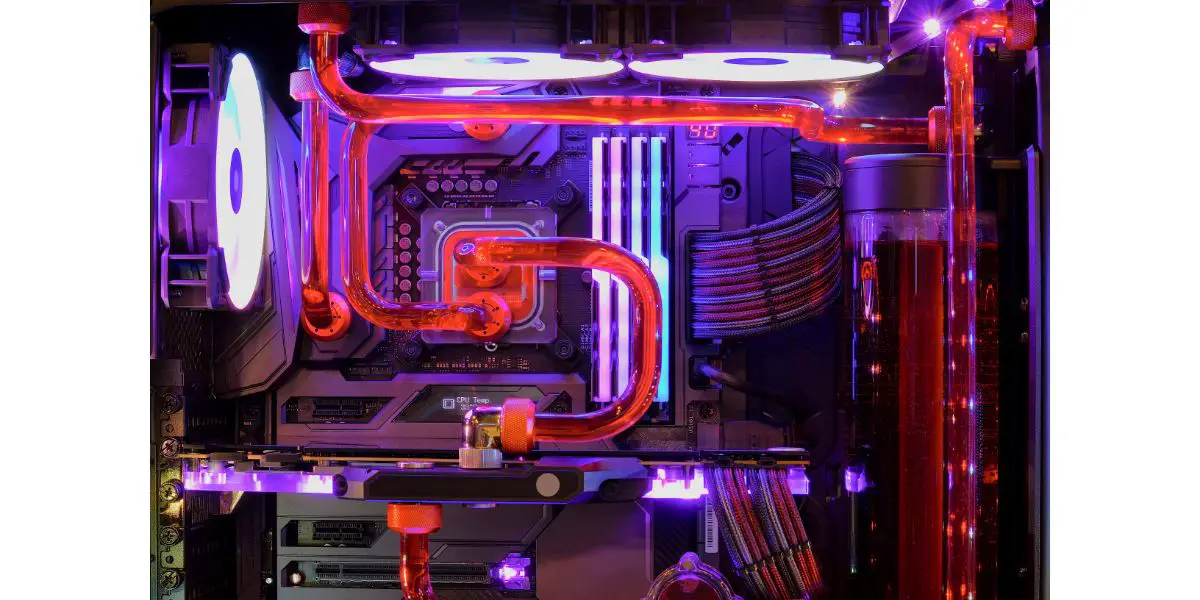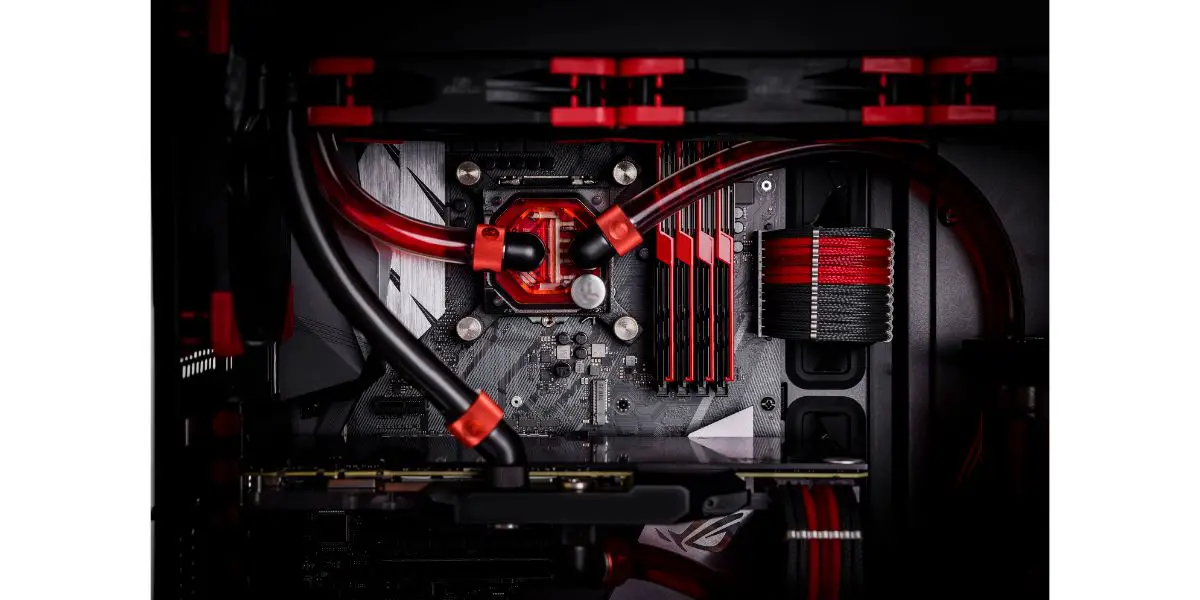Disclaimer: This post may contain affiliate links, meaning we get a small commission if you make a purchase through our links, at no cost to you. For more information, please visit our Disclaimer Page.
Computers today are not just tools but also means of self-expression. Consumers go out of their way to build machines that deliver the highest levels of performance and, at the same time, look amazing. No wonder top-of-the-line components like custom water cooling solutions are so expensive.
Table of Contents
5 Reasons Why Water Cooling Is So Expensive
An All-In-One (AIO) water cooling solution can cost between $250 and $300. If you think that’s steep, consider that a custom-built or open-loop solution can set you back by as much as $400. But why are water-cooling solutions so expensive?
Water cooling is expensive because water cooling technology is more complex than air cooling. As a result, water coolers have more individual components, require greater precision in manufacturing, and are more expensive to make. They can be endlessly customized and only make up a niche market.
Let’s delve deeper into each of these reasons.
1. Water Coolers Have More Individual Components Than Air Coolers
Air cooling systems use air to cool a computer’s most crucial components. Usually, these include a machine’s Central Processing Unit (CPU) and Graphics Processing Unit (GPU).
By contrast, a water-cooling system uses water or a liquid coolant to achieve the same ends. While water cooling is highly effective, it also poses significant engineering challenges.
Notably, water is not a friend of electronic components and can cause significant damage if it leaks into your machine. Thus, safely transporting the liquid coolant of a water-cooling system around your device requires many additional parts to come together in a complex design.
Most air coolers primarily consist of just two primary components: a heat sink and a fan. By contrast, a liquid cooling solution includes numerous components. These include:
- A water block: These are the blocks of metal (usually copper or aluminum) that come into direct contact with a CPU and GPU’s Integrated Heat Spreader (IHS). It is through these that heat from these components is transferred to the liquid coolant in a water cooler.
- A reservoir: The reservoir holds the water cooler’s liquid coolant when it is not in circulation and is an essential node in the coolant circulation chain.
- A pump: The pump pushes the liquid coolant through a water cooler’s tubing around the computer. It plays a crucial role in drawing heat away from computer components to the radiator and fans, from where they can be expelled into the atmosphere and exchanged for cooler air.
- A radiator: The radiator absorbs the heat from the liquid coolant of a water cooler via its fins.
- Fans: Fans help cool the radiator down by blowing hot air away from them and exchanging hot air for cool air.
- Tubing and other accessories: A water cooler also includes extensive tubing to transport the liquid coolant around a computer and numerous fittings to help join different bits to different components of the water-cooling system.
But the greater number of parts is only one of the reasons why water cooling costs more than air cooling.
2. Customized Water Cooling Solutions Require Additional Components
AIO or closed-loop water coolers are simplified solutions that integrate a water-cooling system’s components into one comprehensive package.
By buying an AIO liquid-cooling system, users can avoid purchasing individual components separately. Crucially, this can help them avoid ending up with incompatible parts. AIO solutions are also usually cheaper.
However, AIO systems are less comprehensive than fully customized systems.
Custom or open-loop liquid solutions are tailored for your specific computer. They offer the best performance by ensuring maximum coverage. Often, they are used to cool not just CPUs and GPUs, but the motherboard, Voltage Regulator Modules (VRMs), and RAM as well.
To extend their reach across the different areas of a computer, open-loop liquid cooling solutions often have even more components than AIO liquid-cooling solutions. They have more tubing, which in turn requires more accessories and fittings.
In addition, those purchasing comprehensive systems are often willing to shell out additional funds for features such as:
- Monoblocks
- RAM blocks
- Additional, flow, drain and fill fittings
While open-loop liquid cooling solutions offer the highest cooling performance of any cooling system available today, they are also the most expensive.
3. Water Coolers Require Precision Engineering
Not only do water coolers need more parts than air coolers, but many of the parts of a water cooler also need to be manufactured with a high degree of precision.
As explained in the previous section, the incompatibility of water and electronic hardware makes ensuring that no liquid leaks into the computer absolutely imperative. Even parts that are usually cheap, such as tubing and accessories, require higher-quality inputs and more finesse in production.
The tubes and pipes transferring coolant may be of different sizes and materials. The components and tubes need to be precisely fitted to ensure a completely sealed loop.
The higher degree of precision required to produce liquid cooling solutions means that manufacturers cannot rely to as great a degree on third-party manufacturers to supply different components.
Often, even parts sourced from third-party manufacturers need to be further modified to ensure the best fit. All these modifications require more man and machine hours in the manufacturer’s factory, yet another factor that drives up the cost of liquid cooling solutions.
4. Water Coolers Are Expensive To Make
All of the features listed above make manufacturing liquid cooling systems significantly more expensive than making air-cooling systems.
As high-performance products, liquid cooling solutions tend to use the best quality inputs. Critical components like water blocks need copper or aluminum. And, as mentioned earlier, all the tubing and fittings need to be top-notch to ensure no spillage occurs.
Additionally, components such as water blocks require expensive machinery and significant amounts of time to produce.
For instance, skiving machines are required to shave off extremely fine slivers of metals and precisely carve out micro fins on the surface of water blocks. A single machine can only put out only 30 blocks an hour. Moreover, each machine can cost well over $100,000.
Liquid cooling systems also need to be tested extensively to ensure that no coolant leaks from loops. To ensure the finished products can withstand the scorching temperatures of a fully engaged CPU and GPU, they are even tested inside ovens.
The facilities, equipment, manpower, and hours necessary to produce liquid cooling solutions all add to their cost.
For more in-depth insights into the manufacturing process, check out the following YouTube video that shows a tour of factories manufacturing liquid-cooling products for Cooler Master and Deep Cool in China and Taiwan:
5. The Market for Water Coolers Is Small
While liquid cooling solutions provide very high cooling performance, not everyone needs such top-of-the-line cooling.
Most computer users don’t use their machines for intensive tasks. They may get by on stock coolers that come with CPUs. Beyond these light users, even many who do require third-party cooling solutions are satisfied with the price-performance balance air cooling offers.
Only very few power users require computers with liquid cooling systems. Thus, the market size for these products is relatively smaller. Like many other niche products, liquid cooling solutions can’t be manufactured at the same scales as the most popular mass-manufactured goods.
Because manufacturers of liquid cooling systems do not enjoy the same economies of scale, their products cost more to make. In the end, they pass on these costs to buyers of the product.
Is Liquid Cooling Worth It?
Now that we’ve considered why liquid cooling solutions cost so much, let us examine whether they’re worth shelling out for.
Pros of Liquid Cooling
The advantages of liquid cooling include the following:
- Liquid cooling solutions offer the best performance of any cooling solution on the market. Within liquid cooling, custom-loop solutions offer the best cooling of any liquid cooling system. These systems ensure that your components perform at their maximum capacity for thousands of hours without overheating.
- They are also usually quieter than an air cooling system that relies on many fans to circulate air inside a PC case.
So why doesn’t everyone have a liquid cooling solution in their computer?
Cons of Liquid Cooling
There are a few disadvantages to liquid cooling:
- They are more expensive than air cooling systems.
- They require more expertise to install. Many lay users feel intimidated at the idea of picking the parts for a fully custom-built setup.
- Computer components can be damaged by water. The threat of leakage from the tubes of a liquid cooling system deters many users from installing one in their computers.
Choosing Between Air and Liquid Cooling
If you’re considering whether a liquid cooling solution is right for you, ask yourself the following questions:
- Do I stress my machine out enough to require top-of-the-line cooling performance?
- Am I willing to pay a significant premium for the highest cooling performance?
- Do I know my way around a computer or am I willing to put in the effort to figure out the basics of installation and maintenance for liquid cooling systems?
If you’ve answered yes to all three questions, then liquid cooling is for you. If not, you may want to look into air coolers.
Final Thoughts
Water cooling requires more components, precision engineering, sophisticated design, and extensive product testing. As a niche product, all these features cannot be supplied cheaply by manufacturers, who have to pass the costs to buyers.


